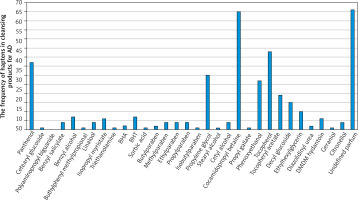Regular skin care and avoidance of triggers are mainstay of atopic dermatitis (AD). Extensive topical use of fragrances and preservatives may contribute to skin irritation and sensitization [1]. Moreover, the clinical benefits of using bath preparations remain a matter of debate [2]. This study aimed to determine the prevalence of contact sensitizers in bath preparations available in Poland.
A systematic analysis of rinse-off cleansing products dedicated to AD patients (described as ‘bath preparations’, ‘emollients for bathing’ and ‘products for AD’, included in different galenic formulations) was performed in most frequently browsed Polish online drugstores (according to https://jobexpress.pl/jak-dlugo-przetrwaja-apteki-stacjonarne; Supplementary Table S1). We analysed the ingredients of rinse-off products, on the basis of the International Nomenclature of Cosmetic Ingredients (INCI), and matched these with 139 haptens listed in the European Baseline Series (EBS), Fragrance Series and Cosmetic Series (Supplementary Table S2), also the “undefined perfume” was added. Parallelly we divided the identified products depending on galenic formulations and compared the number of haptens in the groups.
As of 30 May 2021, 150 bath preparations met our inclusion criteria. We could not determine ingredients in 2% of them. Only 8.7% of rinse-off products (defined above) in Poland were devoid of haptens listed in EBS, Fragrance Series, and Cosmetic Series. The vast majority of rinse-off products (89.3%) contained at least one hapten (up to 8, an average was 2.8 per product). The most common hapten was unspecified perfumes (49.2%), followed by the cocamidopropyl betaine (48.1%), tocopheryl acetate/tocopherol (45.9%), panthenol (27.4%), and propylene glycol (23%) (Figure 1). Additionally, the specific galenic formulation did not determine the number of potential sensitizers (average 2 haptens in emulsions vs. 3.1 in gels and shampoos). All products described as foams and washing creams contained at least one hapten (Supplementary Figure S1).
Figure 1
Analysis of bath preparations for patients with AD based on haptens from the European Baseline Series, Cosmetic and Fragrance series

In this study we provide a list of the most common haptens in bath preparations, which corresponds with our previous research showing that numerous emollients display certain allergenic potential [3, 4]. However, rinse-off products are usually less harmful than leave-on cosmetics as they are diluted by water and quickly rinsed with water.
Remarkably perfumes, the most common haptens, are not perceived by the parents as a deleterious element of atopic skincare cosmetics [5]. Interestingly, adding the panthenol, an infrequent but relevant sensitizer, to Cosmetic Series constitutes a necessary anchorage of the new approach. On the other hand, some of widespread haptens in cosmetics (e.g. cocamidopropyl betaine, phenoxyethanol, propylene glycol, tocopherol) very rarely cause allergic contact dermatitis.
According to the ‘epithelial barrier hypothesis’, some of haptens present in everyday skin care products are meant to promote increased skin permeability and the development of food allergy [6]. However, the potential sensitizers mentioned in our studies have rarely been described as being the causes of sensitization in rinse-off products, such as bath products, even in atopic individuals.
We emphasize the importance of manufacturing skincare products for AD patients that will contain only haptens with known insignificant sensitizing potential.








